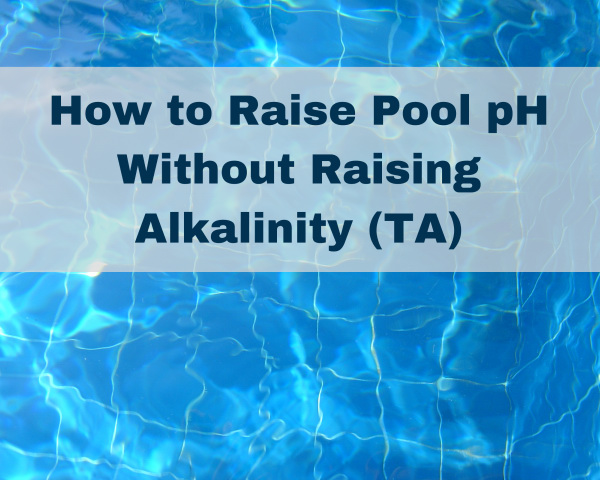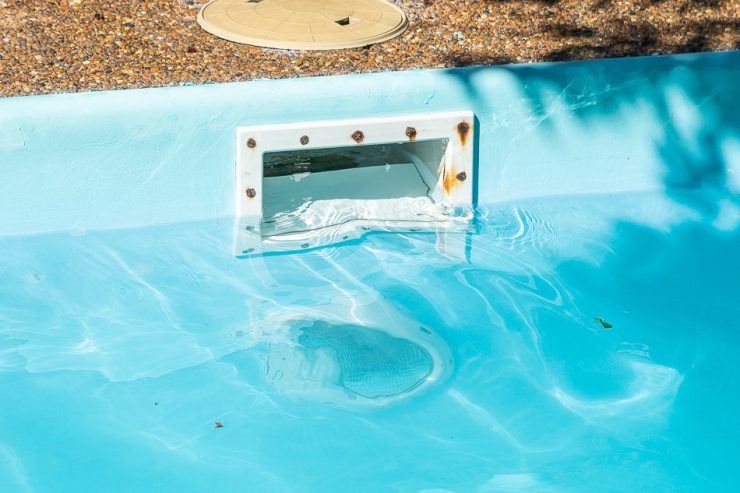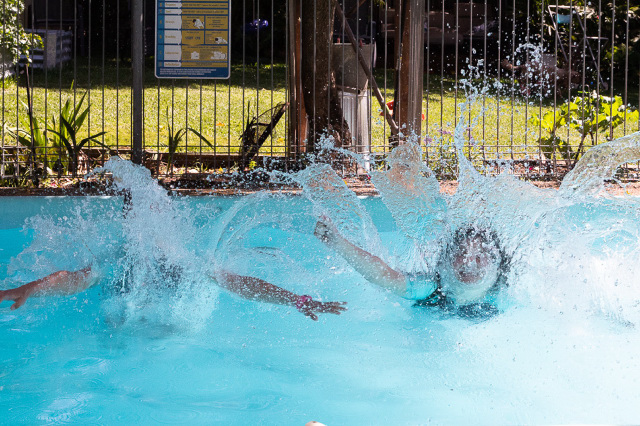Total Alkalinity (TA) greatly influences your pool’s pH. Therefore, when pH rises, so does the alkalinity. So, when you notice a low pH in your pool but it has a normal TA range, how do you raise pH without increasing total alkalinity.
Although it can be tricky, it is possible to raise pH without impacting the total alkalinity level of your pool. The two most common methods are aeration or adding borax to the water.
Which method suits you best depends on your preferences. This is particularly the case when handling borax as it’ll increase the presence of borates.

Article Contents
What Causes Low pH?
Culprits causing low pH in your pool include:
- chlorine type
- heavy rainfall
- high bather load
- overdosing pH lowering chemicals
- the presence of too much dirt
Chlorine Type
If your pool is regularly testing a low pH, the most common cause is likely the use of chlorine tablets or stabilized chlorine. These forms of chlorine usually have a pH of 3 and lower when added to the water. Switching to liquid chlorine is a simple fix here.
Heavy Rain & Debris
Heavy rainfall or leaf debris can also cause low pH. The easiest solution is to invest in a pool cover. A pool cover will random debris from entering the pool during heavy showers/storms.
But, if you worry about using a pool cover and running your pool pump, our guide Can You Run Your Pool Pump With The Swimming Pool Cover On? has you covered. Plus, it mentions some of the different pool cover types that might suit you best!
High Bather Load
No matter how rigorous you are with keeping your pool clean, it’s impossible to stop dirt from entering. In addition, people naturally release oils, hairs, and sweat during the day. All this (and sunscreen) can cause the pH to lower.
To offset this sort of pH interference, consider asking pool visitors to rinse off before dipping into the pool.
Effects of Low pH
Once you realize your pool’s pH level is reading low, it’s crucial to normalize it before there’s any lasting damage to your pool. Some effects of low pH are:
- damage to vinyl liners (they can get brittle or stiff)
- metallic elements (ladders, lights) being subject to corrosion and rust
- the erosion of grout and plaster
- plaster parts (skimmers & pool lights) becoming brittle
Aside from pool effects, you might experience skin irritation and sore eyes if you continue to swim in a low pH pool.

Why Would You Need to Raise pH But NOT Alkalinity?
The main reason to raise pH and not alkalinity is that your pool’s total alkalinity is in a normal range. Total alkalinity is responsible for buffering the fluctuations of pH.
There are many reasons your pool’s pH would be low, but that doesn’t automatically mean that alkalinity drops with it. Total alkalinity acts as a pH regulator, but it doesn’t maintain pH level. If alkalinity is low, pH will be subject to large fluctuations and swings. If alkalinity is high, the pH level will be difficult to change.
Understanding the relationship between pH and alkalinity can be confusing. One is a scale, and the other is a measurement of concentration. If you’re still unsure what the differences are, check our guide: What is Total Alkalinity in Pools | pH vs. Alkalinity
Does Raising Alkalinity Also Raise pH?
Simply put, raising alkalinity will raise pH. This is because alkalinity and pH link so closely to each other that they tend to rise and fall together.
However, they don’t fall and rise by the same amounts. So, it’s possible to raise the total alkalinity without significantly affecting your pool’s pH level.
But, if raising total alkalinity into a normal range (80-120 ppm) pushes pH too high, you can add a pH decreaser like Clorox pH Down to bring the pH back down. You can get it here:
- Reduces pH to protect equipment and surfaces
- Optimizes sanitizer efficiency & helps prevent algae
- For pools and spas
Will Baking Soda Raise pH But Not Alkalinity (TA)?
Unfortunately, when you add baking soda to your pool, you will raise the alkalinity and pH.
Baking soda, otherwise known as sodium bicarbonate, is alkaline. Therefore, adding it to water will raise the pH slightly. However, baking soda will also increase total alkalinity because of its own alkalinity.
For example, adding 1.5 lb (0.7 kg) of baking soda to a 10,000-gallon (45,500 L) pool will raise alkalinity by 10 ppm while only slightly raising the pH level. To raise the pH, it’s common to need at least 5 lbs (2.3 kg) of baking soda.
Therefore, drastically changing the alkalinity level. Which is not what is normally desired.
Will Soda Ash Raise pH But Not Alkalinity (TA)?
When you add soda ash to your pool, you will raise pH. Soda ash does have a small impact on the alkalinity and will raise it a little too.
Soda ash, also known as sodium carbonate, is another highly alkaline substance. However, it has a higher pH than baking soda (11.3-11.7 vs. 8).
Soda ash will affect alkalinity but won’t bump it out of its normal range. For instance, adding 6 oz (0.2 kg) of soda ash to a 10,000-gallon (45,500 L) pool will raise pH by 0.2 while increasing alkalinity by 5 ppm.
Soda ash is a good choice of chemical to use if your alkalinity is where you want it but pH is low. It will raise pH in large steps without overly raising the alkalinity.
Can You Raise pH without Raising Alkalinity (TA)?
pH and alkalinity closely intertwine with each other. So when you raise pH, it’s challenging not to affect the alkalinity.
Wanting to raise pH without affecting the total alkalinity does happen. But, it isn’t easy to raise pH without also raising alkalinity, however minimally. Luckily, there is a way to do just that.
Introducing more air into the pool water (aeration) is a natural way of raising pH with no impact on alkalinity. There are no chemicals here to interfere with alkalinity. There are several ways to aerate your pool water (listed below), and none include added costs.
Chemicals to Raise pH But Not Alkalinity
The best chemical to raise pH while minimally raising alkalinity is borax. Because borax is not a carbonate, the effect on alkalinity will be negligible.
Borax, sodium borate, is a common household white powdery acid ideal for removing mold or brightening laundry. But it is also a great solution to raising pH without knocking alkalinity out of its normal range.
- Multipurpose cleaning agent
- DIY laundry soap, fabric softener & carpet freshener
- Always pure ingredients with no additives
Baking soda and soda ash contain carbonates, so alkalinity will increase as it interacts. But, because borax doesn’t contain carbonate, the alkalinity effect is minimal.
However, borax doesn’t dissolve like other pH Up products, so you need to be aware of the build-up of borates in your pool. Many pool owners prefer to keep their borate levels below 50 ppm, although a few report no issues with maintaining levels of 100 ppm.
If your pool contains too much borax, it can cause the pH to spike and make it challenging to restabilize. And swimming in a high-borate-containing pool can lead to nausea, vomiting, and more severe health risks.
You can check the borates with this test kit.
- Single dip and read test strip procedure
- Optimized color chart
- 50 test strips
How to Raise pH without Raising Alkalinity
The two ways to raise pH without raising or increasing alkalinity. They are:
- aeration
- add borax
- add soda ash
Whichever method, or combination of both, you choose will depend on things such as the cost and time spent on correcting pH.
Aeration will Increase pH without Increasing Alkalinity
Aeration is achieved by constantly churning the pool water for a prolonged time. Even though it takes a long time to aerate your pool, you don’t need any chemicals. And, without the presence of chemicals, alkalinity won’t move.
Different ways to aerate your pool water:
- Keep your pool pump running
- Turn on any water features you have
- Get people to splash vigorously
- Point your pool jets upwards, so it breaks the water surface

This method could take hours or days to raise the pH back to a normal range. It will depend on how much you need to raise the pH and how rigorously you aerate the water.
There is also a limit on how much aeration can raise the pH. So if the pH is very low to start with, you might need to resort to adding borates or borax to the water.
Borax will Increase pH without Increasing Alkalinity
Choosing to add Borax to raise pH will be much faster than through aeration alone. But, it will minimally raise alkalinity, which may suit pools with wiggle room.
How much Borax you’ll need will depend on how much you need to raise the pH, the current total alkalinity, and how much borates are already in the water. Steps to add Borax are below.
1. Find Your Pool’s Capacity
- Find the pool volume by checking the pool owner’s manual.
- Or, if you don’t have the manual, use a pool volume calculator like this one.
2. Test Your Pool’s Water Chemistry
- Using pool test strips, find out the current total alkalinity, borate level, and how much the pH needs raising. You can try these test strips:
- Suit pools and spas
- Tests 7 things including chlorine, bromine, pH, cyanuric acid
- Quick & easy to use
3. Run Pool Pump and Filter
- Ensure your pool pump and filter run at full capacity before adding borax.
4. Measure and Add Borax
- Add the borax to the skimmer and allow it to circulate for at least 24 hours.
- It will depend on the current pH level and total alkalinity. Start with 40 ounces of borax for every 10,000 gallons of pool water.
5. Retest Pool’s Water Chemistry
- Retest the water to find a new pH level. Then, repeat these steps if the pH is still low.
- Borates should be around 30-50 ppm.
If you want to speed up the Borax raising pH, use one of the aeration methods in addition to adding Borax.
Soda Ash will Increase pH without Overly Increasing Alkalinity
As mentioned early in this article, Soda Ash will mostly increase the pH level of a pool and will only slightly raise the pH.
If the alkalinity of your pool isn’t too high, then Soda Ash is a viable option. Soda Ash can cause cloudy water though. This is usually temporary and can last anything from a few hours to a few weeks.
Tips to Prevent a Low pH
Some quick tips to prevent your pool’s pH from dropping include:
- Regularly skimming and vacuuming, mainly to pick up visible debris and mulch.
- Fit a pool cover during heavy rain or storms.
- Finally, ask pool users to rinse off before entering the pool. (This will help prevent pollutant transference.)
Related Reading: Low PH in Pool: How to Raise
Final Thoughts
Maintaining your pool’s water chemistry can be mind-boggling, especially when dealing with chemicals that affect each other’s levels.
Even though they greatly influence each other, raising pH with little to no impact on your pool’s total alkalinity is possible.
Related Reading:
How Long Does It Take to Heat a Hot Tub? (and Tips for Faster Heating)
How to Lower Alkalinity in Pool Without Affecting pH
Does Adding Chlorine Change Pool pH Level?






Borax. It cannot be said enough. Twenty-Mule Borax. Cheap and very effective. NEVER use baking soda in your pool…. EVER, no matter what the box says.
Borax is great for alkalinity. Baking Soda is OK as long as you test your water with a quality kit first and apply in moderation.